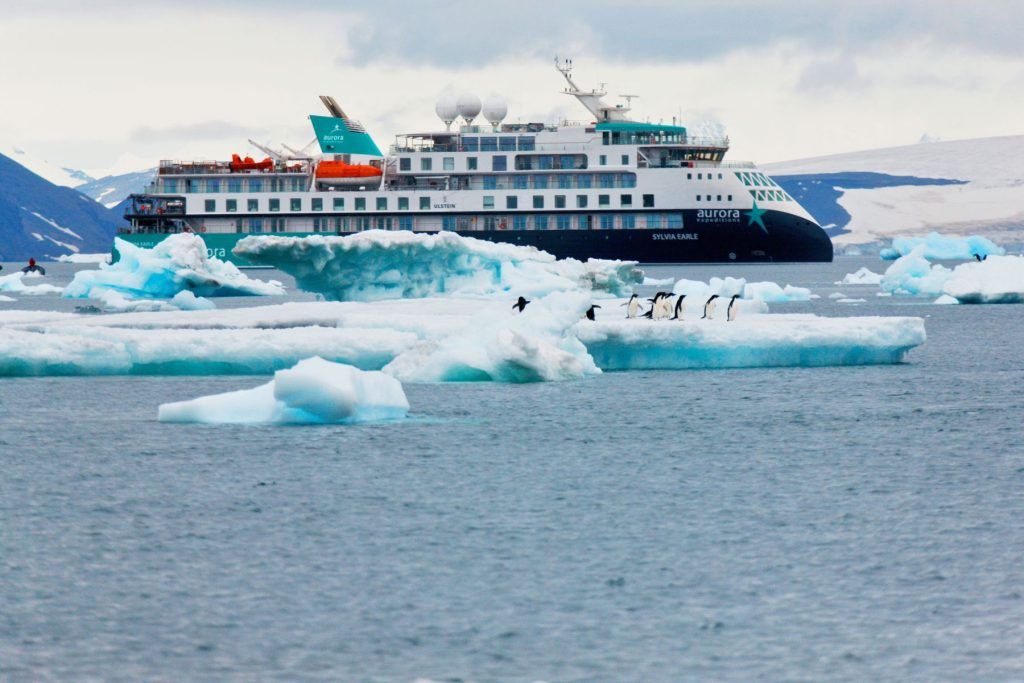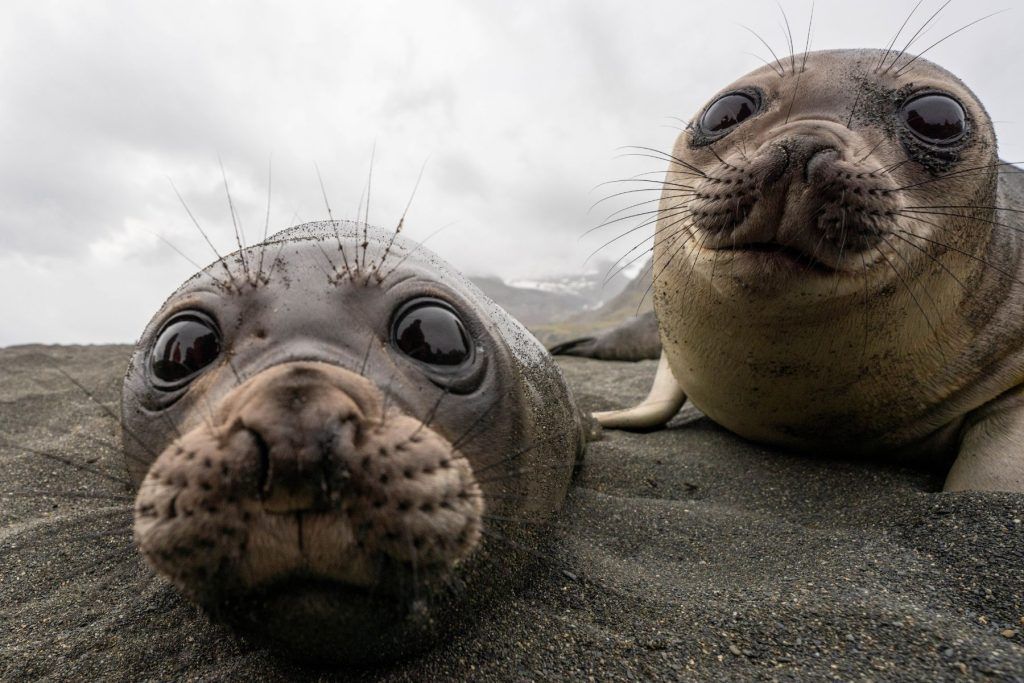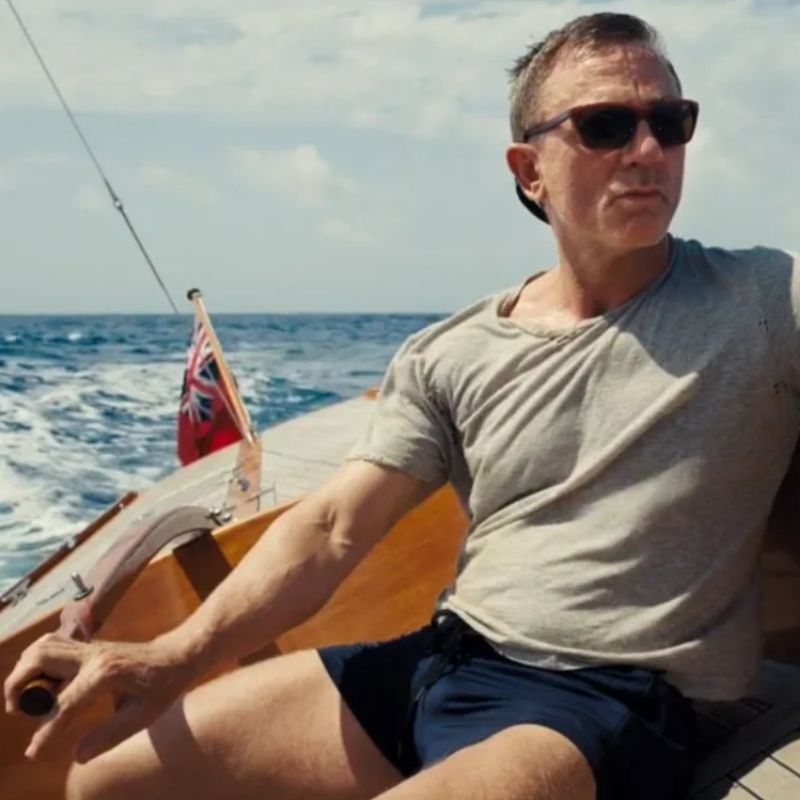
With its wedding-cake glaciers, seemingly prehistoric animal populations, and dramatic snow-capped terrain, Antarctica is one of the world’s wildest destinations, even aboard a luxury cruise. Sailing the new Sylvia Earle by Aurora Expeditions, our writer discovers there are no shortcuts to the most inhabitable place on earth.

A burst of excitement ripples through the aircraft cabin. We all spring into action. Passengers are stripping off in the aisle, others are adding layers: beanies, gloves, waterproof pants. After three days in limbo and the threat of cancellation to our fly-in, fly-out Antarctica cruise due to bad weather, we’ll soon be landing on King George Island in the South Shetland Islands. We slip in just before sunset, any later and the aircraft, which has the difficult task of landing on a short, gravel runway (and must do so in daylight), would need to turn around and make the two-hour flight back to Punta Arenas, a fate that had already met a handful of groups this season.

I squeeze my mum. We step out into the frozen dusk amid cheers. Darkness is already falling by the time the transfer bus reaches the shore. Off in the distance, the 71-cabin Sylvia Earle, the newest ship in the Aurora Expeditions fleet, named after the 88-year-old marine biologist and deep-sea explorer (who, having joined the previous trip, is personally waving to us from the makeshift terminal) is lit up like a beacon. With frozen hands and faces, we scramble to put on our muck boots and lifejackets for a wet, choppy ride in the zodiac to the mothership. It’s been a stressful start, but once we step onto this luxurious vessel, our home for the next six nights, our anxiety fades into disbelief. Disbelief that we are here, that we made it, that my mum and I are doing this together.

I travelled to the Great White Continent with the intention of writing a story about how I discovered the easiest way to get to Antarctica. My mum (her name is Sue) is travelling with me to celebrate her 70th birthday, and together we were set to embark on an 11-day Aurora Expeditions journey around the Antarctic Peninsula that would have us skip the notorious Drake Passage completely and fly to meet the ship instead. But I soon learn that easy doesn’t exist in Antarctica, and nor should it. Like all life-changing journeys, ours takes an unexpected turn, proving that there are no shortcuts in the world’s most uninhabitable place.
Waiting game

Our journey began with a test of patience. We’d been hanging out in the hotel lobby for two long days awaiting news, or worst-case scenario, cancellation of our cruise. Those days were a blur of buffets, belly laughs with new friends and an unhealthy amount of speculation. “In 10 years of operation, this is the first time I’ve had to cancel a trip,” says Tomas Holik, vice president of operations at Aurora Expeditions, when quizzed during an update in Punta Arenas.
Weather has not been favourable for fly-in trips to Antarctica this season. Aurora Expeditions company protocol is to cancel after three days if the group still hasn’t been able to fly. With only three charter planes and a group from a different operator still attempting to get there when we arrive, there’s a backlog. By day two, morale is low. Tomorrow morning is our last chance, and with two plane loads of people to shuttle there, it doesn’t look promising.
But then we make it. By a sheer thread, we make it.
The final frontier

The first morning I awake to icebergs and a horizon of white as the ship cruises towards Recess Cove. It takes a while for me to process that we are actually here. This landing is our first and only on the continent of Antarctica. I’ve joined the polar snorkelling program on this trip, so sadly my mum and I make land separately, and tick off our seventh and final continent in the presence of our thoughts, but not each other. I soon discover that she can tag along with me on my snorkelling zodiac, so we’re mostly attached at the hip for the rest of the cruise.
After the landing, we meet in our twin-bed Balcony Stateroom Category B cabin, which is located on level 4 of the eight-level ship, and I find mum a little rattled, having taken a little tumble in the drink upon disembarkation. Thankfully the heated flooring in our small ensuite is handy for getting things dry overnight. Our cabin is on level 4 with floor-to-ceiling glass doors that open out onto the deck. In uniform with the rest of the Sylvia Earle, it’s tastefully decorated with wildlife portraits from Antarctica and the Arctic, shot by the company’s talented photographer experts.
As well as being carbon neutral(!), the ship is a spectacular base, with various lounge areas and comforts such as self-servings of hot beef bouillon after outings. There’s a main dining room where we share delicious meals with our new friends from the U.K., U.S. and Australia. Deck 8, which serves up steakhouse-style fare, is reservation only. There’s a sauna and two outdoor Jacuzzis, where mum and I retire most afternoons with a couple of glasses of bubbly, and the Sylvia Earle also boasts a library and lecture area. Passengers meet here every evening for an update from expedition leader (and founder of Australian Geographic) Howard Whelan and other experts. “Try to be present in the places that we visit,” Howard advises. “Don’t rush.”
Solitude and silence

After just a day here, one thing in particular strikes me. The silence. No planes or cars, obviously, but neither rustling trees nor even birds. Antarctica is deafeningly quiet, albeit from the disconcerting cracks of glaciers and resulting chunks of ice that tumble like liquid thunder into the bays and coves. Some glaciers are heavily frosted like a layered wedding cake, others are striped with blue, as if licked with minty gel toothpaste. “It’s kind of addictive, like watching a fire,” says my mum as we peer out the window transfixed by this vulnerable, harsh landscape that is under threat, with data showing record low sea ice this year.
Over the next five days, I wiggle into a dry-suit every morning and get into the freezing Southern Ocean. Amid the ice soup, I peer underneath the water, my face numb from the cold. We don’t see much on our snorkelling trips, but as we’re the first zodiac off the ship and always with the same crew of people, it feels a like an exclusive experience. “Why take the bus when you can ride the limo,” says Edwin, our Arizona-based, Aussie-born snorkelling guide, who masquerades as a helicopter pilot in the off-season.
One morning in Graham Passage we skip the snorkel entirely and fang it for whales we can see breaching in the distance. They’re too far to reach, but a pod of humpbacks close to the zodiacs keeps us entertained for hours. The zodiac is handy for accessing spots the ship can’t, and we see many gentoo, chinstrap and adelie penguins, as well as seals of all flavours: fur, Weddell, crabeater, elephant and the prehistoric-like leopard.
Lingering landscapes

The landscapes in Antarctica are mighty, with Lemaire Passage a highlight. We wake just after sunrise and head to the observation deck to watch as the ship passes through a narrow thoroughfare of soaring snow-capped mountains that start to glow in the golden light. At British base Port Lockroy on day five, we tour the museum of the old research station and send postcards back home from the Penguin Post Office. Everything about this experience is surreal. One night, after a barbecue, we don hats and have a dance party on the upper outdoor deck. We cruise into one of the world’s only caldera volcanos at Deception Island. Throughout the trip, whale bones and old whaling and sealing stations are prudent reminders of an ugly past at the hands of humans.
It’s a white-out when we approach our final stop at Elephant Point, where a two-tonne elephant seal is doing the worm towards a freezing puddle of water. The snowflakes are the biggest I’ve ever seen. According to on-board geologist and glaciologist Dr. Ulyana Horodyskyj, it’s an indicator of a warming ocean. Likewise, due to the melting sea ice, penguin chicks are being born later in the season here, with only 30 to 40 percent surviving each year. “You are experiencing climate change before your very eyes,” Ulyana says.

But we have the ability to turn this trajectory around. “Humanity has shown itself to be able to problem-solve, especially through the covid pandemic,” she says. “I don’t think this is any different. We can rise to the occasion and turn these tipping points in time. If we believe in the power of humanity to make a difference, we can solve climate change.”
Antarctica is a wild ride. But caring for the planet will be our most important journey yet.
Aurora Expeditions Antarctic Explorer, 12-day Fly/Fly cruise from US$19,895 per person, auroraexpeditions.com.au.
Lede image photo by Tyson Mayr and all images courtesy of Aurora Expeditions.


















